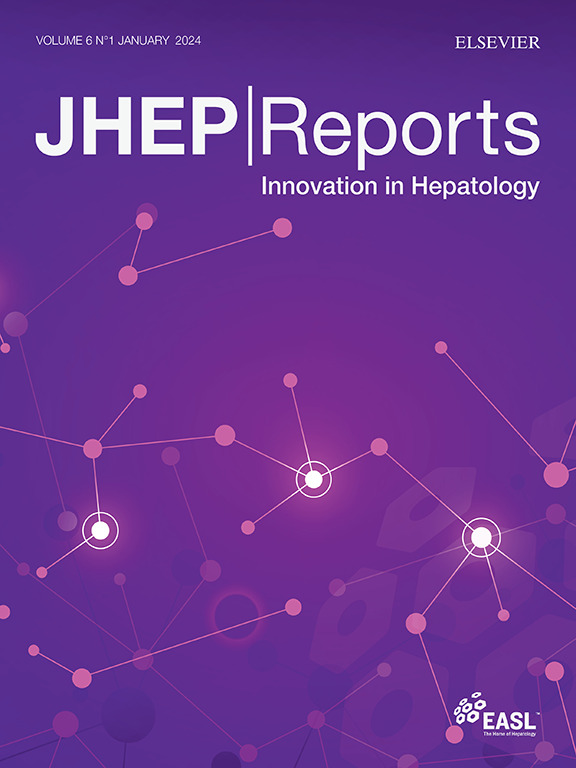可溶性TREM2和PRO-C3作为预测MASLD活性变化的生物标志物的能力
IF 7.5
1区 医学
Q1 GASTROENTEROLOGY & HEPATOLOGY
引用次数: 0
摘要
背景,饮食和减肥仍然是大多数代谢功能障碍相关脂肪肝(MASLD)患者的主要治疗方法,最近有一种药物治疗被批准用于严重病例。然而,对于能够帮助临床医生评估治疗反应的非侵入性测试(NITs)的需求仍然很大。我们旨在探讨几种nit反映组织学非酒精性脂肪性肝病(NAFLD)活动评分(NAS)至少一个点变化的能力。方法本研究探讨了173例二级护理伴有2型糖尿病或严重肥胖的患者治疗反应的生物标志物,所有患者均接受了反复的肝脏活检和血液样本。我们测量了可溶性触发受体在骨髓细胞2 (TREM2)、胶原标志物PRO-C3、PRO-C4、PRO-C6、PRO-C8和PRO-C18L上的表达,并通过FibroScan、FAST-score和胰岛素抵抗稳态模型评估(HOMA-IR)测量肝脏硬度。我们在两个不同的队列中研究了生物标志物的变化及其反映肝活检改变的能力,使用比较配对分析和多变量logistic回归来评估结果。结果平均年龄为52岁(±12岁),38%为男性,52%基线时NAS≥3(90/173),70%为F0-F1纤维化,23%(39/173)为代谢功能障碍相关脂肪性肝炎。NAS变化在sTREM2、PRO-C3、HOMA-IR和fast评分水平上有显著差异(恶化、无变化、改善)(p = 0.0001)。在多变量分析中,sTREM2 + PRO-C3和HOMA-IR预测NAS改善(AUROC & 0.75),每单位减少的优势比为1.13 (p = 0.001, 95% CI 1.04-1.21)。FIB-4和非酒精性脂肪性肝病纤维化评分(NFS)未反映NAS改善(AUROC <0.60, OR <1.05, p >0.5)。结论strem 2、PRO-C3和HOMA-IR表明NAS改善,值得进一步研究作为衡量干预反应的替代标志物。影响和意义:非侵入性检查(NITs)将在监测代谢功能障碍相关脂肪变性肝病的治疗反应中发挥关键作用,为肝活检提供了一种可行的替代方法。我们的研究调查了NITs是否反映了基于2型糖尿病或肥胖患者非酒精性脂肪性肝病(NAFLD)活动评分(NAS)变化的组织学反应。我们使用非侵入性标记,其中一些对应于疾病严重程度的不同生物学方面。我们发现某些NIT水平的降低与NAS减少和复合组织学改善(小叶炎症和球囊)密切相关。结合髓细胞表达的可溶性触发受体2,PRO-C3或稳态模型评估胰岛素抵抗增强了监测NAS改善的潜力。ClinicalTrials RegistrationClinicalTrials.gov (NCT03068078;NCT03535142)。本文章由计算机程序翻译,如有差异,请以英文原文为准。

Ability of soluble TREM2 and PRO-C3 as biomarkers to predict changes in MASLD activity
Background & Aims
Diet and weight loss remain the primary treatment for most patients with metabolic dysfunction-associated fatty liver disease (MASLD), with one recent drug therapy approved for severe cases. However, a significant need remains for non-invasive tests (NITs) that can assist clinicians in evaluating treatment response. We aimed to explore the ability of several NITs to reflect a change of at least one point in histologic non-alcoholic fatty liver disease (NAFLD) Activity Score (NAS).
Methods
This study explores biomarkers reflecting treatment response in 173 patients from secondary care with type 2 diabetes or severe obesity, all of whom underwent repeated liver biopsies and blood samples. We measured soluble triggering receptor expressed on myeloid cells 2 (TREM2), collagen markers PRO-C3, PRO-C4, PRO-C6, PRO-C8, and PRO-C18L and liver stiffness measured by FibroScan, FAST-score, and homeostatic model assessment of insulin resistance (HOMA-IR). We studied biomarker changes and their capacity to reflect liver biopsy alterations in two distinct cohorts, using comparative paired analyses and multivariable logistic regression to evaluate the results.
Results
Mean age was 52 years (±12), 38% male, 52% had NAS ≥3 at baseline (90/173), 70% had F0–F1 fibrosis, and 23% (39/173) had metabolic dysfunction-associated steatohepatitis. Significant differences were seen in sTREM2, PRO-C3, HOMA-IR, and FAST-score levels by NAS changes (worsened, no-change, improved) (p = 0.0001). In multivariable analysis, sTREM2 + PRO-C3 and HOMA-IR predicted NAS improvement (AUROC >0.75), with an odds ratio of 1.13 for each unit decrease (p = 0.001, 95% CI 1.04–1.21). FIB-4 and non-alcoholic fatty liver disease fibrosis score (NFS) did not reflect NAS improvement (AUROC <0.60, OR <1.05, p >0.5).
Conclusions
sTREM2, PRO-C3, and HOMA-IR indicate NAS improvement and warrant further investigation as surrogate markers for gauging intervention response.
Impact and implications
Non-invasive tests (NITs) will play a crucial role in monitoring treatment responses in metabolic dysfunction-associated steatotic liver disease, providing a viable alternative to liver biopsies. Our study investigates whether NITs reflect histological responses based on changes in the non-alcoholic fatty liver disease (NAFLD) activity score (NAS) in patients with type 2 diabetes mellitus or obesity. We used non-invasive markers, some corresponding to different biological aspects of disease severity. We found that reductions in certain NIT levels correlate well with NAS reduction and composite histological improvements (lobular inflammation and ballooning). Combining soluble triggering receptor expressed on myeloid cells 2, PRO-C3, or homeostatic model assessment of insulin resistance enhances the potential for monitoring NAS improvement.
Clinical Trials Registration
ClinicalTrials.gov (NCT03068078; NCT03535142).
求助全文
通过发布文献求助,成功后即可免费获取论文全文。
去求助
来源期刊

JHEP Reports
GASTROENTEROLOGY & HEPATOLOGY-
CiteScore
12.40
自引率
2.40%
发文量
161
审稿时长
36 days
期刊介绍:
JHEP Reports is an open access journal that is affiliated with the European Association for the Study of the Liver (EASL). It serves as a companion journal to the highly respected Journal of Hepatology.
The primary objective of JHEP Reports is to publish original papers and reviews that contribute to the advancement of knowledge in the field of liver diseases. The journal covers a wide range of topics, including basic, translational, and clinical research. It also focuses on global issues in hepatology, with particular emphasis on areas such as clinical trials, novel diagnostics, precision medicine and therapeutics, cancer research, cellular and molecular studies, artificial intelligence, microbiome research, epidemiology, and cutting-edge technologies.
In summary, JHEP Reports is dedicated to promoting scientific discoveries and innovations in liver diseases through the publication of high-quality research papers and reviews covering various aspects of hepatology.
 求助内容:
求助内容: 应助结果提醒方式:
应助结果提醒方式:


